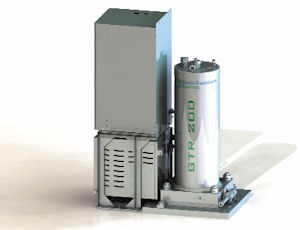Not ready to give up on the alternative energy storage system they had developed while with Pentadyne Power Corp., former executives from that closed company started a new venture to get the technology into mass transit systems around the globe. The team behind Kinetic Traction Systems pins the hopes of the fledgling start-up on a contract to complete a project for the Long Island Railroad in which the flywheels can absorb energy from braking trains and then release it back into the system. The engineering and development work was completed before Pentadyne went under this summer and Kinetic would do the manufacturing of the 12 flywheels and construction of the building to house them. The long-term hope of its executives is to be a supplier to large original equipment manufacturers to mass transit systems in North America, Europe and Asia. “Even in the short-time we’ve had this there’s been a lot of positive interest and feedback,” said Chandler Williamson, vice president of sales and chief marketing officer. Williamson, CEO Richard Newark, and Rudi Lautz, the CFO, all worked together at Pentadyne. The offices and manufacturing space of Kinetic Traction in Chatsworth had been used by Pentadyne until the sudden closure in July. Founded in 1998, Pentadyne was made up of two divisions: the uninterrupted power supply business that sold flywheels to hospitals, data centers, television stations and other uses where a loss of power could not be afforded; and the rail business, which was still in its infancy. The sale of the flywheels to mass transit systems was expected to be the growth area for the company as it was the uninterrupted power supply business that was losing money, said Newark, who served as chief operating officer at Pentadyne. Investor pulls out An investor who was going to put money into the company pulled out at the last minute. Pentadyne did not have enough money to keep going and was burdened by heavy debt, owing $9 million to two private investment firms in both direct and indirect loans. Assets of the company were sold off to pay creditors. The UPS business went to Phillips Service Industries, a manufacturer in Michigan, with the rail side flywheels, patents and intellectual property going to Kinetic Traction. One of the challenges Kinetic Traction faces, Newark admitted, was the taint that goes with insolvency and to get potential customers to look past what happened with Pentadyne and recognize the new company on its own merits. That is especially the case with the New York Power Authority, which awarded the contract for the Long Island Railroad and the agency Kinetic Traction execs must convince to continue the work started by Pentadyne. As the flywheel technology is not in question and Kinetic Traction is more than prepared and qualified to complete the work, it all comes back to the question of image. The authority is more used to working with larger, established companies so a start-up has it skittish, Newark said. “We are optimistic we can win that one,” Newark added. Bid in China The company also has an active bid to supply flywheels for a $30 million, 21-station light rail project on the island of Macau in China. The goal Newark, Williamson and Lautz are set on is to become a supplier to the larger firms of electrified mass transit. The company has had talks with several such companies that have been promising. Becoming a supplier broadens the market distribution and gives Kinetic Traction a global reach, Williamson said. “The companies can take the flywheels and integrate it into products they are already selling,” Williamson said. While the current design of the flywheel equipment – a cabinet with electronic components, a vacuum box, and the cylinder containing the carbon fiber wheel – was inherited from Pentadyne, there are ways to make improvements. For instance, the cabinet can be made smaller and the wheel made to rotate faster than it current top speed of 36,000 rpm.
